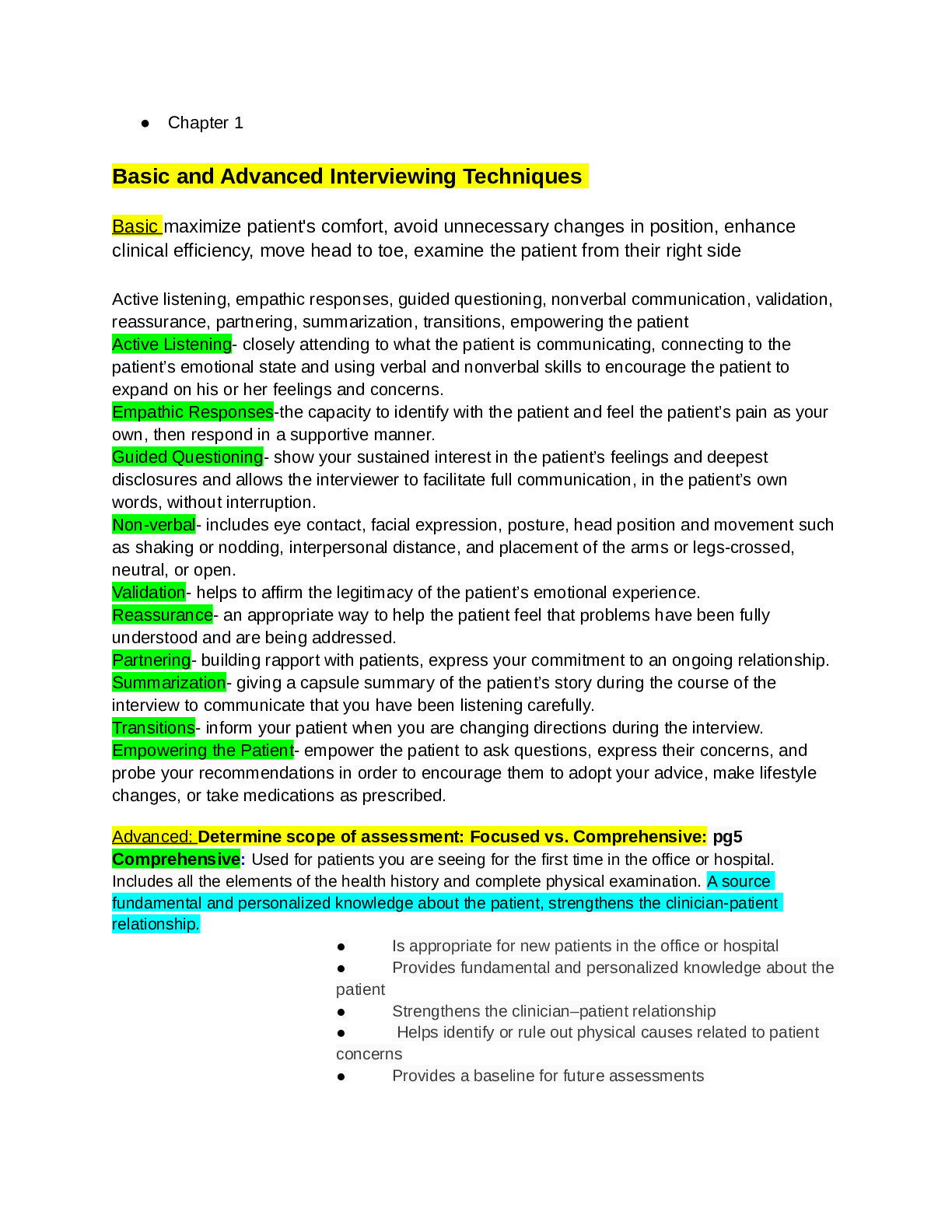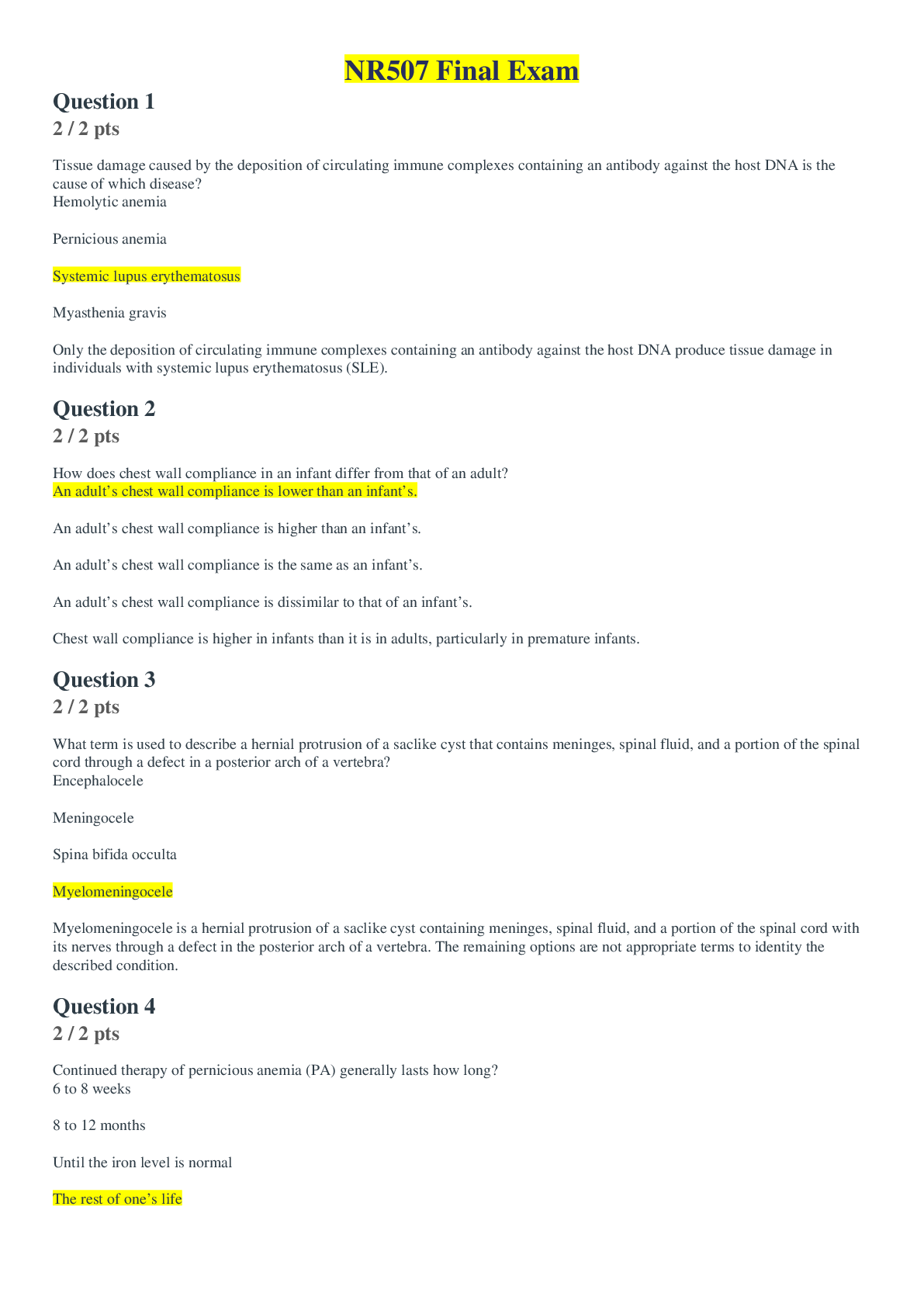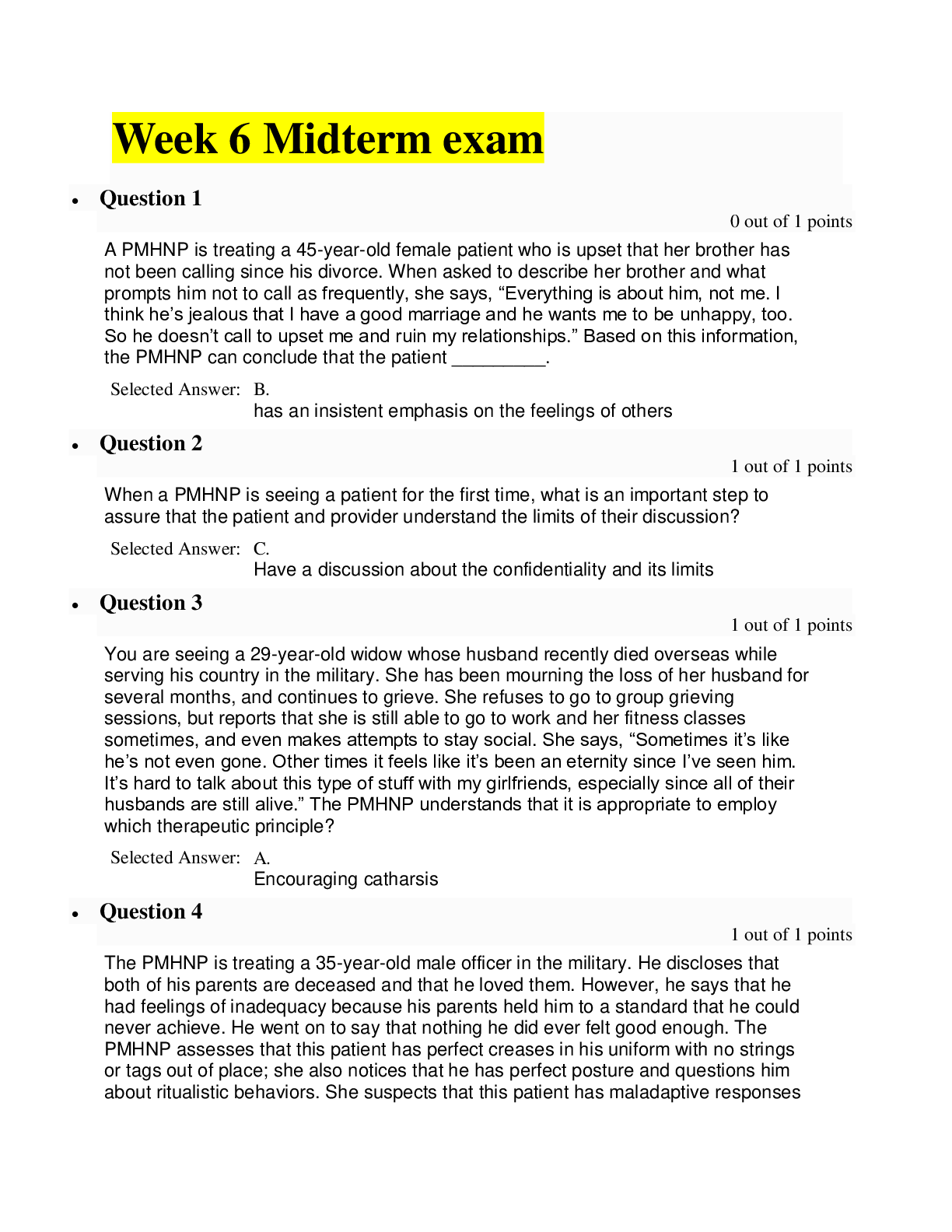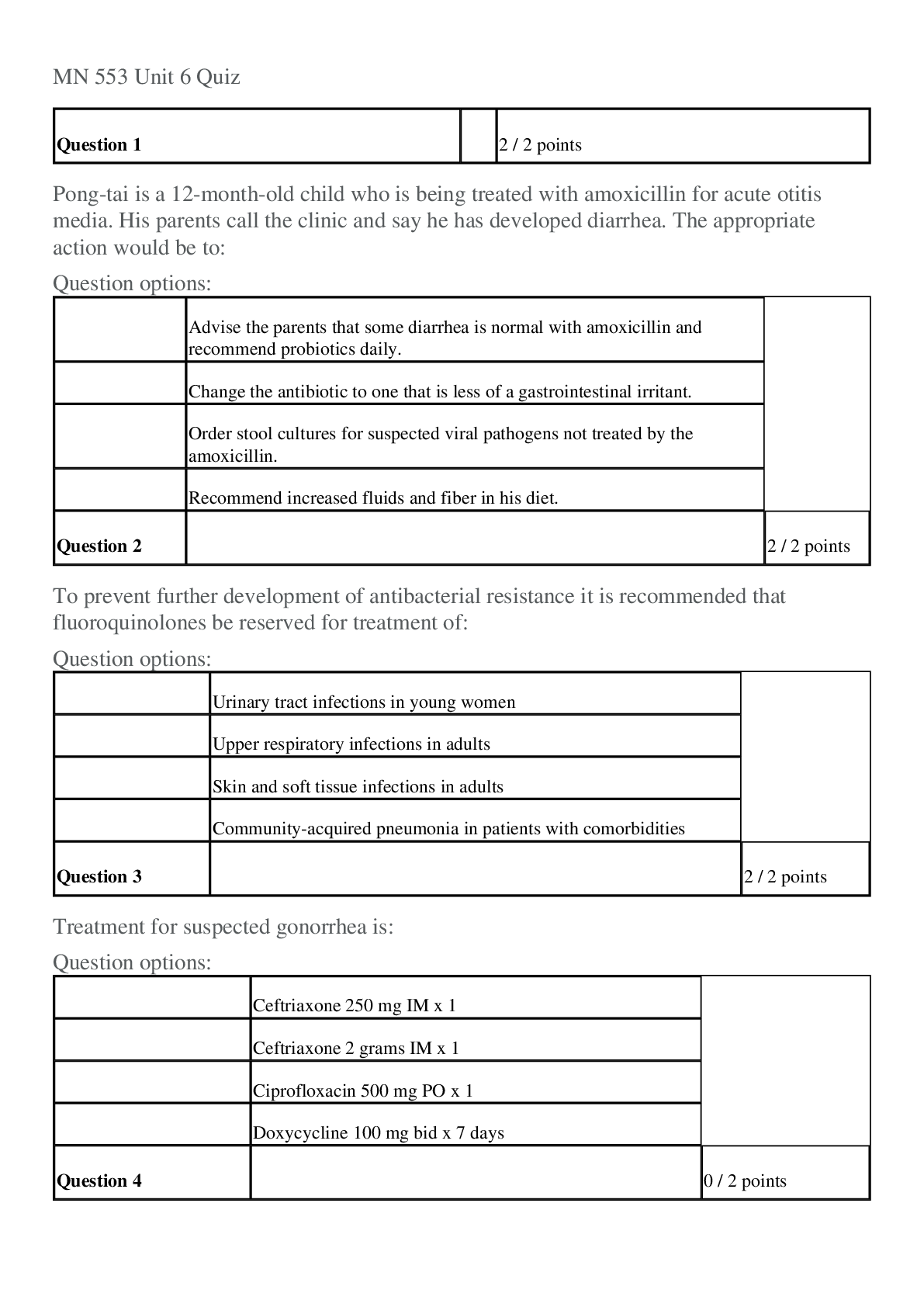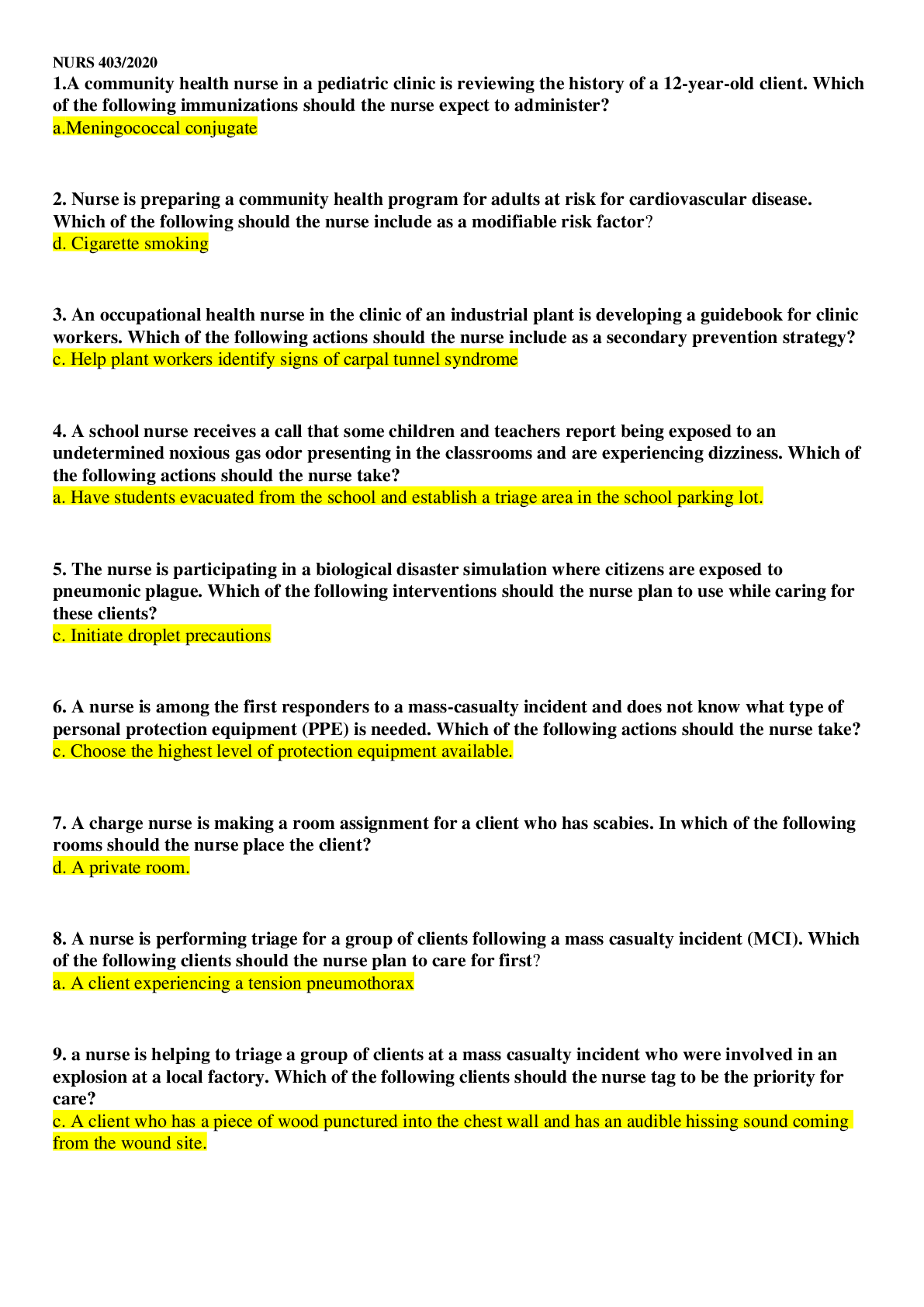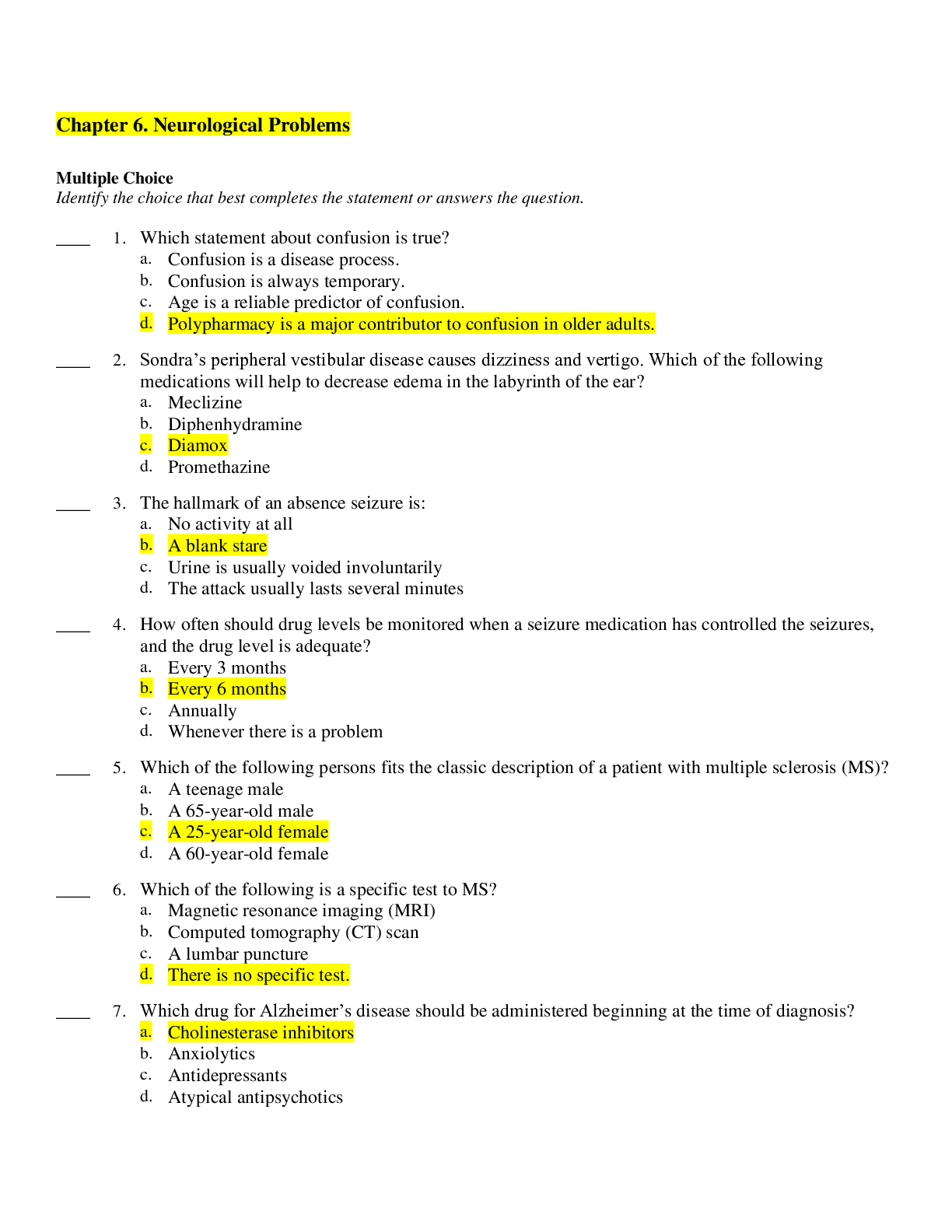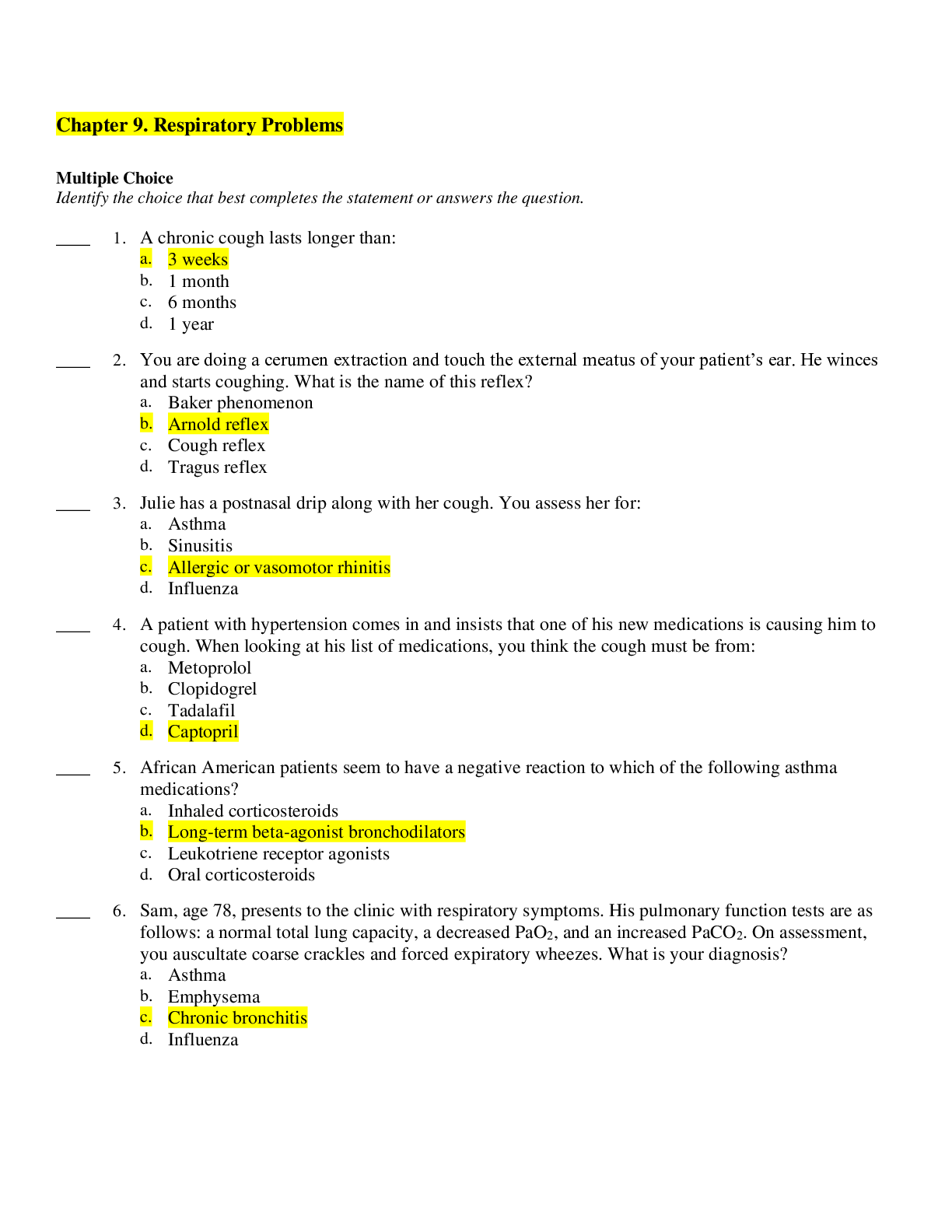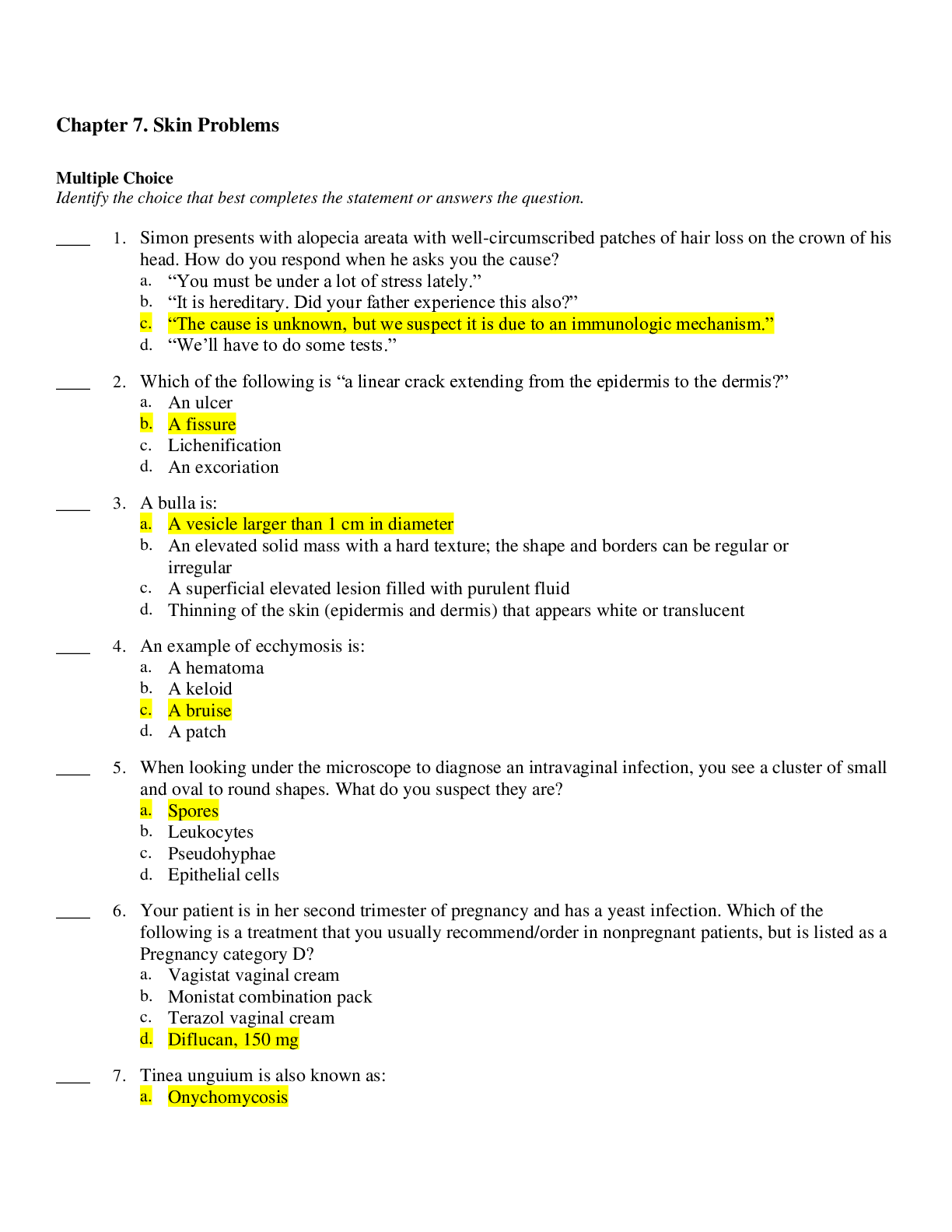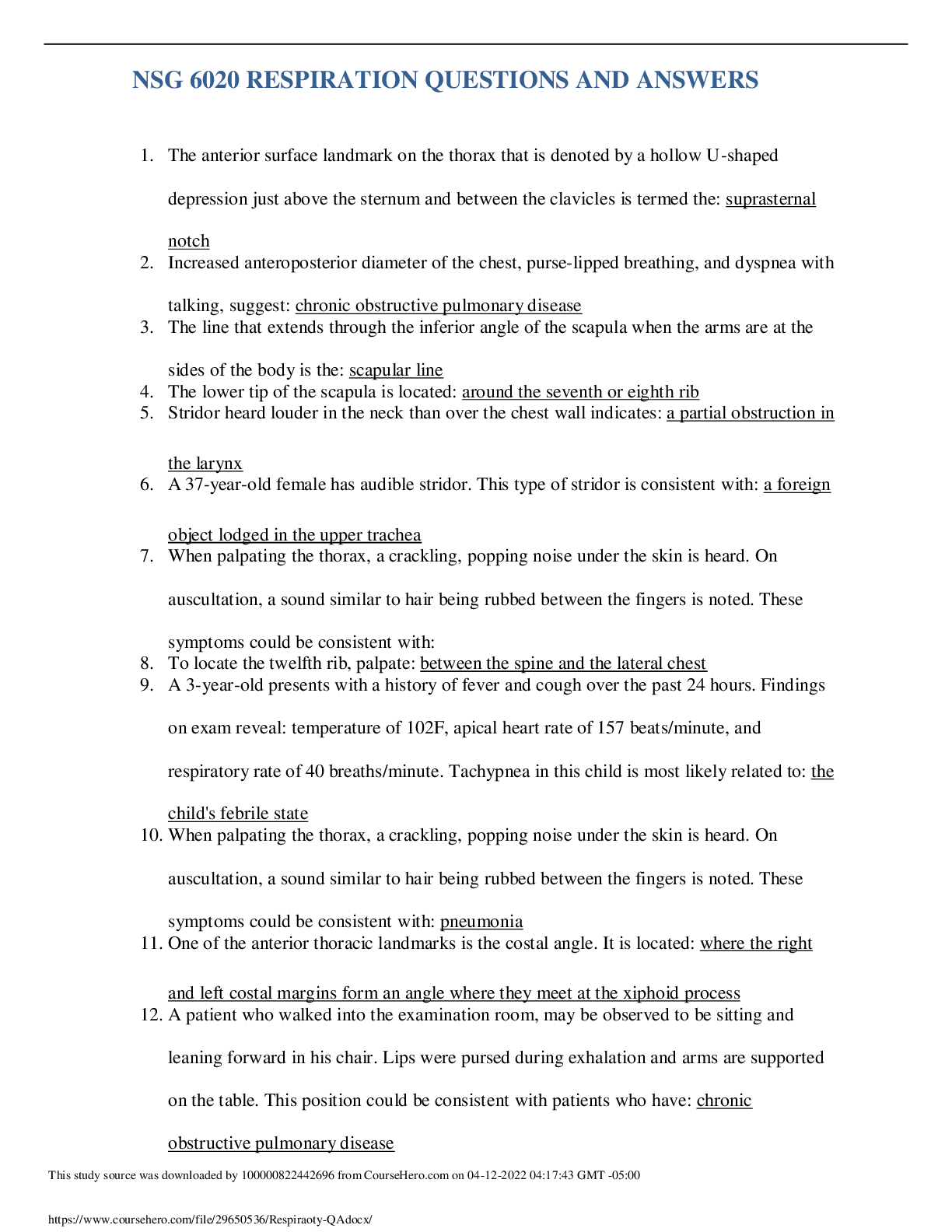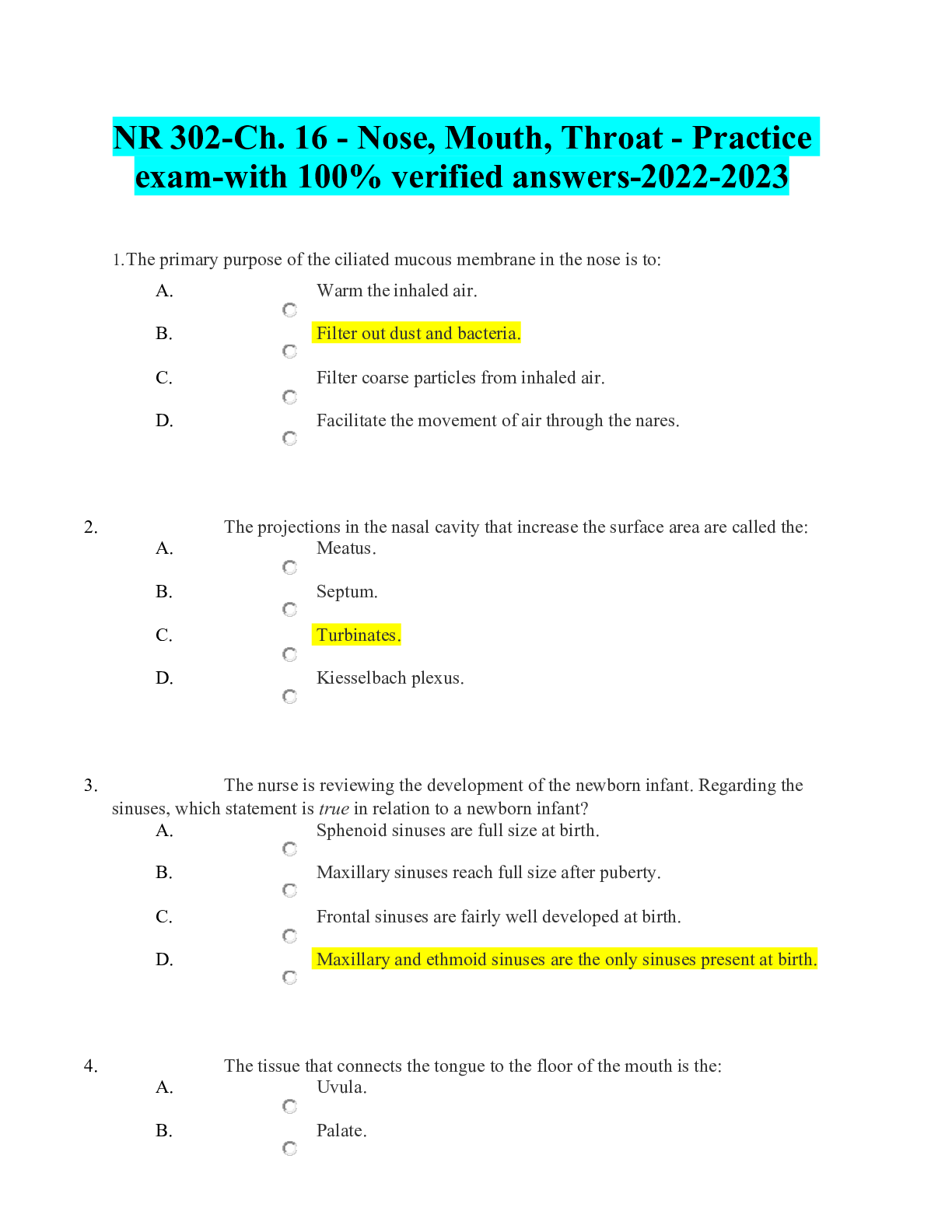*NURSING > EXAM > Keiser University - NURSING NUR3065 Ch 8 Ears Nose Mouth Throat Questions And Answers/Already Graded (All)
Keiser University - NURSING NUR3065 Ch 8 Ears Nose Mouth Throat Questions And Answers/Already Graded A.
Document Content and Description Below
Chapter 8. Eyes, Ears, Nose, and Throat Multiple Choice Identify the choice that best completes the statement or answers the question. ____ 1. An acutely presenting, erythematous, tender lump w... ithin the eyelid is called: a. Blepharitis b. Hordeolum c. Chalazion d. Iritis ____ 2. The clinician is seeing a patient complaining of red eye. The clinician suspects conjunctivitis. The presence of mucopurulent discharge suggests which type of conjunctivitis? a. Viral conjunctivitis b. Keratoconjunctivitis c. Bacterial conjunctivitis d. Allergic conjunctivitis ____ 3. Which subtype of cataracts is characterized by significant nearsightedness and a slow indolent course? a. Nuclear cataracts b. Cortical cataracts c. Posterior cataracts d. Immature cataracts ____ 4. Which of the following statements is true concerning the use of bilberry as a complementary therapy for cataracts? a. The body converts bilberry to vitamin A, which helps to maintain a healthy lens. b. Bilberry blocks an enzyme that leads to sorbitol accumulation that contributes to cataract formation in diabetes. c. Bilberry boosts oxygen and blood delivery to the eye. d. Bilberry is a good choice for patients with diabetes as it does not interact with antidiabetic drugs. ____ 5. A 65-year-old man presents to the clinician with complaints of increasing bilateral peripheral vision loss, poor night vision, and frequent prescription changes that started 6 months previously. Recently, he has also been seeing halos around lights. The clinician suspects chronic open-angle glaucoma. Which of the following statements is true concerning the diagnosis of chronic open-angle glaucoma? a. The presence of increased intraocular pressure measured by tonometry is definitive for the diagnosis of open-angle glaucoma. b. The clinician can definitively diagnosis open-angle glaucoma based on the subjective complaints of the patient. c. Physical diagnosis relies on gonioscopic evaluation of the angle by an ophthalmologist. d. Early diagnosis is essential in order to reverse any damage that has occurred to the optic nerve. ____ 6. Acute angle-closure glaucoma involves a sudden severe rise in intraocular pressure. Which of the following ranges represents normal intraocular pressure? a. 0 to 7 mm Hg b. 8 to 21 mm Hg c. 22 to 40 mm Hg d. 40 to 80 mm Hg ____ 7. As diabetic retinopathy progresses, the presence of ‘cotton wool’ spots can be detected. Cotton wool spots refer to: a. Nerve fiber layer infarctions b. Blood vessel proliferation c. Venous beading d. Retinal hemorrhage ____ 8. Which of the following is an example of sensorineural hearing loss? a. Perforation of the tympanic membrane b. Otosclerosis c. Cholesteatoma d. Presbycusis ____ 9. The clinician is assessing a patient complaining of hearing loss. The clinician places a tuning fork over the patient’s mastoid process, and when the sound fades away, the fork is placed without restriking it over the external auditory meatus. The patient is asked to let the clinician know when the sound fades away. This is an example of which type of test? a. Weber test b. Schwabach test c. Rinne test d. Auditory brainstem response (ABR) test ____ 10. A patient presents to the clinician complaining of ear pain. On examination, the clinician finds that the patient has tenderness on traction of the pinna as well as when applying pressure over the tragus. These findings are classic signs of which condition? a. Otitis media b. Meniere’s disease c. Tinnitus d. Otitis externa ____ 11. Otitis media is considered chronic when: a. Inflammation persists more than 3 months with intermittent or persistent otic discharge. b. There are more than six occurrences of otitis media in a 1-year period. c. Otitis media does not resolve after two courses of antibiotics. d. All of the above ____ 12. The most significant precipitating event leading to otitis media with effusion is: a. Pharyngitis b. Allergies c. Viral upper respiratory infection (URI) d. Perforation of the eardrum ____ 13. Patients with acute otitis media should be referred to a specialist in which of the following situations? a. Concurrent vertigo or ataxia b. Failed closure of a ruptured tympanic membrane c. If symptoms worsen after 3 or 4 days of treatment d. All of the above ____ 14. Which immunoglobulin mediates the type 1 hypersensitivity reaction involved in allergic rhinitis? a. IgA b. IgE c. IgG d. IgM ____ 15. Fluctuations and reductions in estrogen may be a contributing factor in which type of rhinitis? a. Vasomotor rhinitis b. Rhinitis medicamentosum c. Atrophic rhinitis d. Viral rhinitis ____ 16. Sinusitis is considered chronic when there are episodes of prolonged inflammation with repeated or inadequately treated acute infection lasting greater than: a. 4 weeks b. 8 weeks c. 12 weeks d. 16 weeks ____ 17. Which of the following antibiotics provides the best coverage in acute or chronic sinusitis when gram-negative organisms are suspected? a. Penicillin V b. Amoxicillin c. Levofloxacin d. Clindamycin ____ 18. In which of the following situations would referral to a specialist be needed for sinusitis? a. Recurrent sinusitis b. Allergic sinusitis c. Sinusitis that is refractory to antibiotic therapy d. All of the above ____ 19. Which type of stomatitis results in necrotic ulceration of the oral mucous membranes? a. Vincent’s stomatitis b. Allergic stomatitis c. Apthous stomatitis d. Herpetic stomatitis ____ 20. The presence of hairy leukoplakia in a person with no other symptoms of immune suppression is strongly suggestive of which type of infection? a. HSV type 2 b. HIV c. Pneumonia d. Syphilis ____ 21. Heart valve damage resulting from acute rheumatic fever is a long-term sequelae resulting from infection with which of the following pathogens? a. Coxsackievirus b. Cytomegalovirus c. Francisella tularensis d. Group A streptococcus ____ 22. A patient presents with the following signs and symptoms: gradual onset of low-grade fever, marked fatigue, severe sore throat, and posterior cervical lymphadenopathy. Based on the signs and symptoms alone, which of the following conditions is most likely the cause? a. Gonorrhea b. Mononucleosis c. Influenza d. Herpes zoster ____ 23. A patient presents to the clinician with a sore throat, fever of 100.7F, and tender anterior cervical lymphadenopathy. The clinician suspects strep throat and performs a rapid strep test that is negative. What would the next step be? a. The patient should be instructed to rest and increase fluid intake as the infection is most likely viral and will resolve without antibiotic treatment. b. Because the patient does not have strep throat, the clinician should start broad spectrum antibiotics in order to cover the offending pathogen. c. A throat culture should be performed to confirm the results of the rapid strep test. d. The patient should be treated with antibiotics for strep throat as the rapid strep test is not very sensitive. ____ 24. Which of the following medications used in the treatment of glaucoma works by constricting the pupils to open the angle and allow aqueous fluid to escape? a. Pilocarpine b. Timolol c. Brinzolamide d. Acetazolamide ____ 25. You have a patient who is a positive for Strep on rapid antigen testing (rapid strep test). You order amoxacillin after checking for drug allergies (patient is negative) but he returns 3 days later, reporting that his temperature has gone up, not down (101.5 F in office). You also note significant adenopathy, most notably in the posterior and anterior cervical chains, some hepatomegaly, and a diffuse rash. You decide: a. to refer the patient. b. that he is having an allergic response and needs to be changed to a macrolide antibiotic. c. that his antibiotic dosage is not sufficient and should be changed. d. that he possibly has mononucleosis concurrent with his strep infection. ____ 26. You are in the park playing with your children when you see that your friend is screaming for help. Her toddler has fallen and there is a stick lodged in his eye. The child is kicking and screaming and grabbing for the stick. You: a. instruct his mother to hold him securely and not allow him to touch the stick, then carefully remove the stick from the eye. b. stabilize the foreign object and accompany the mother and child to the local ER. c. find a water fountain, hold the child to the water, and flush the eye. d. call 911. True/False Indicate whether the statement is true or false. __F__ 1. Severe pain associated with acute otitis media signifies perforation of the tympanic membrane. Chapter 8. Eyes, Ears, Nose, and Throat Answer Section [Show More]
Last updated: 1 year ago
Preview 1 out of 6 pages
Instant download

Buy this document to get the full access instantly
Instant Download Access after purchase
Add to cartInstant download
Reviews( 0 )
Document information
Connected school, study & course
About the document
Uploaded On
Aug 05, 2020
Number of pages
6
Written in
Additional information
This document has been written for:
Uploaded
Aug 05, 2020
Downloads
0
Views
51


